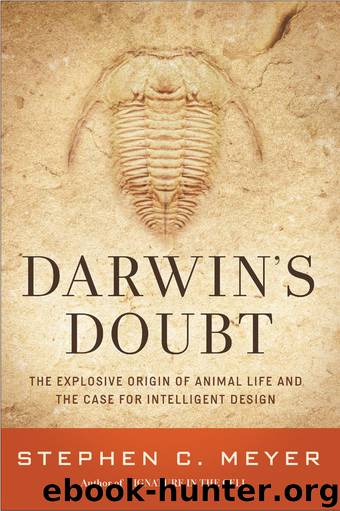Darwin's Doubt: The Explosive Origin of Animal Life and the Case for Intelligent Design by Stephen C. Meyer

Author:Stephen C. Meyer [Meyer, Stephen C.]
Language: eng
Format: epub, azw3, mobi
Tags: Science, Non-Fiction, Religion, Philosophy
ISBN: 9780062071491
Google: V4wic0sHGB8C
Amazon: 0062071475
Barnesnoble: 0062071475
Goodreads: 15818327
Publisher: HarperOne
Published: 2013-06-17T22:00:00+00:00
16
Other Post-Neo-Darwinian Models
When Stephen Jay Gould was first wrestling with the question of how new forms of animal life could have arisen so quickly in the fossil record, he considered many possible mechanisms of change. In the famed 1980 paper in which he declared neo-Darwinism “effectively dead,”1 he didn’t just propose allopatric speciation and species selections as new evolutionary mechanisms. He also granted a rehearing to a long discredited idea. Specifically, he argued that large-scale “macromutations” might generate significant innovations in form relatively quickly.2
In the 1930s and 1940s, this idea had been associated with University of California at Berkeley geneticist Richard Goldschmidt. Aware of the many discontinuities in the fossil record, Goldschmidt envisioned radical transformations in the form of animals arising in even one generation as the result of such large-scale mutations. He endorsed, for instance, the view of the German paleontologist Otto Schindewolf (1896–1971) that “the first bird hatched from a reptilian egg” and, thus, in Goldschmidt’s words, “that the many missing links in the paleontological record are sought for in vain because they have never existed.”3 If a bird hatched directly from a reptilian egg as the result of heritable, large-scale mutations, then such a sudden leap or “saltation” would obviously leave no fossil intermediates behind.
Neo-Darwinists rejected this idea as biologically implausible in the extreme. They argued that changing so many functionally integrated anatomical and physiological systems so quickly would inevitably result in deformed mutants, not different integrated systems of organs constituting a whole new animal.4 Goldschmidt’s macromutations, they contended, would produce not what Goldschmidt called “hopeful monsters,” but “hopeless monsters”—that is, nonviable organisms.5
Though Gould wanted to reconsider a role for large-scale mutations, he carefully disassociated his proposal from Goldschmidt’s much ridiculed idea. Instead, he suggested that the mutations affecting genes in animal development might generate larger increments of morphological innovation than the mutations that affected other genes. These “developmental mutations,” he thought, might generate modular parts of biological systems in a short time—without needing to generate whole new forms of life in a single generation. He offered, as an example, the possibility that the gill arch bones of ancient jawless fish, though not the whole fish, might have arisen in one step as the result of a developmental macromutation. Gould explained: “I do not refer to the saltational origin of entire new designs, complete in all their complex and integrated features. . . . Instead, I envisage a potential saltational origin for the essential features of key adaptations.”6
In response to heavy criticism from neo-Darwinists, Gould later downplayed the role of such larger-scale developmental mutations in the theory of punctuated equilibrium. Other evolutionary biologists, however, took his idea as an inspiration and developed theories that emphasize such developmental mutations as a driving force in macroevolution. Evolutionary theorists and developmental biologists such as Rudolf Raff, Sean B. Carroll, and Wallace Arthur have developed a subdiscipline of biology known as evolutionary developmental biology, or “evo-devo” for short. The evolutionary developmental biologists have since formulated alternative models that challenge a key aspect of the neo-Darwinian triad.
Download
Darwin's Doubt: The Explosive Origin of Animal Life and the Case for Intelligent Design by Stephen C. Meyer.azw3
Darwin's Doubt: The Explosive Origin of Animal Life and the Case for Intelligent Design by Stephen C. Meyer.mobi
This site does not store any files on its server. We only index and link to content provided by other sites. Please contact the content providers to delete copyright contents if any and email us, we'll remove relevant links or contents immediately.
The Lost Art of Listening by Michael P. Nichols(7388)
Why I Am Not A Calvinist by Dr. Peter S. Ruckman(4088)
The Rosicrucians by Christopher McIntosh(3455)
Wicca: a guide for the solitary practitioner by Scott Cunningham(3118)
Signature in the Cell: DNA and the Evidence for Intelligent Design by Stephen C. Meyer(3057)
Real Sex by Lauren F. Winner(2950)
The Holy Spirit by Billy Graham(2880)
To Light a Sacred Flame by Silver RavenWolf(2757)
The End of Faith by Sam Harris(2676)
The Gnostic Gospels by Pagels Elaine(2459)
Waking Up by Sam Harris(2380)
Nine Parts of Desire by Geraldine Brooks(2313)
Jesus by Paul Johnson(2294)
Devil, The by Almond Philip C(2266)
The God delusion by Richard Dawkins(2253)
Heavens on Earth by Michael Shermer(2225)
Kundalini by Gopi Krishna(2128)
Chosen by God by R. C. Sproul(2114)
The Nature of Consciousness by Rupert Spira(2034)
